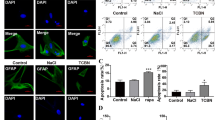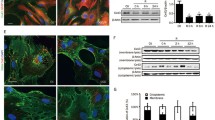Abstract
Astrocytes play a fundamental role in the pathogenesis of ischemic neuronal death. The optimal operation of electrogenic astrocytic transporters and exchangers for some well-defined astrocyte brain homeostatic functions depends on the presence of K+ channels in the cell membranes and the hyperpolarized membrane potential. Our previous study showed that astrocytes functionally express two-pore domain K+ channel TREK-1, which helps to set the negative resting membrane potential. However, the roles of TREK-1 on astrocytic function under normal and ischemic conditions remain unclear. In this study, we investigated the expression of TREK-1 protein on cultured astrocytes and the effect of TREK-1 activity on astrocytic glutamate clearance capacity and release of s100β after simulated ischemic insult. TREK-1 immunoreactivity was up-regulated after hypoxia. Suppression of TREK-1 activity inhibited the glutamate clearance capability, enhanced the inflammatory secretion of astrocytes derived s100β and led to increased neuronal apoptosis after ischemic insult. Our results suggest that TREK-1 activity is involved in astrocytic function and neuronal survival. This would provide evidence showing astrocytic TREK-1 involvement in ischemia pathology which may serve as a potential therapeutic target in stroke.




Similar content being viewed by others
References
Asano T, Mori T, Shimoda T, Shinagawa R, Satoh S, Yada N, Katsumata S, Matsuda S, Kagamiishi Y, Tateishi N (2005) Arundic acid (ONO-2506) ameliorates delayed ischemic brain damage by preventing astrocytic overproduction of S100B. Curr Drug Targets CNS Neurol Disord 4:127–142
Blondeau N, Lauritzen I, Widmann C, Lazdunski M, Heurteaux C (2002) A potent protective role of lysophospholipids against global cerebral ischemia and glutamate excitotoxicity in neuronal cultures. J Cereb Blood Flow Metab 22:821–834
Buckler KJ, Honore E (2005) The lipid-activated two-pore domain K+ channel TREK-1 is resistant to hypoxia: implication for ischaemic neuroprotection. J Physiol 562:213–222
Chu KC, Chiu CD, Hsu TT, Hsieh YM, Huang YY, Lien CC (2010) Functional identification of an outwardly rectifying pH- and anesthetic-sensitive leak K(+) conductance in hippocampal astrocytes. Eur J Neurosci 32:725–735
Djukic B, Casper KB, Philpot BD, Chin LS, McCarthy KD (2007) Conditional knock-out of Kir4.1 leads to glial membrane depolarization, inhibition of potassium and glutamate uptake, and enhanced short-term synaptic potentiation. J Neurosci 27:11354–11365
Franks NP, Honoré E (2004) The TREK K2P channels and their role in general anaesthesia and neuroprotection. Trends Pharmacol Sci 25:601–608
Gerlach R, Demel G, König HG, Gross U, Prehn JH, Raabe A, Seifert V, Kögel D (2006) Active secretion of S100B from astrocytes during metabolic stress. Neuroscience 1411:697–1701
Haring JH, Hagan A, Olson J, Rodgers B (1993) Hippocampal serotonin levels influence the expression of S100 beta detected by immunocytochemistry. Brain Res 631(1):119–123
Heurteaux C, Guy N, Laigle C, Blondeau N, Duprat F, Mazzuca M, Lang-Lazdunski L, Widmann C, Zanzouri M, Romey G, Lazdunski M (2004) TREK-1, a K+ channel involved in neuroprotection and general anesthesia. EMBO J 23:2684–2695
Honore E (2007) The neuronal background K2P channels: focus on TREK1. Nat Rev Neurosci 8:251–261
Kim D (2005) Physiology and pharmacology of two-pore domain potassium channels. Curr Pharm Des 11:2717–2736
Kliot M, Smith GM, Siegal JD, Silver J (1990) Astrocyte-polymer implants promote regeneration of dorsal root fibers into the adult mammalian spinal cord. Exp Neurol 109:57–69
Kucheryavykh LY, Kucheryavykh YV, Inyushin M, Shuba YM, Sanabria P, Cubano LA, Skatchkov SN, Eaton MJ (2009) Ischemia increases TREK-2 channel expression in astrocytes: relevance to glutamate clearance. Open Neurosci J 3:40–47
Li ZB, Zhang HX, Li LL, Wang XL (2005) Enhanced expressions of arachidonic acid-sensitive tandem-pore domain potassium channels in rat experimental acute cerebral ischemia. Biochem Biophys Res Commun 327(4):1163–1169
Matsui T, Mori T, Tateishi N, Kagamiishi Y, Satoh S, Katsube N, Morikawa E, Morimoto T, Ikuta F, Asano T (2002) Astrocytic activation and delayed infarct expansion after permanent focal ischemia in rats: Part I. Enhanced astrocytic synthesis of s-100beta in the periinfarct area precedes delayed infarct expansion. J Cereb Blood Flow Metab 22:711–722
Medhurst AD, Rennie G, Chapman CG, Meadows H, Duckworth MD, Kelsell RE, Gloger II, Pangalos MN (2001) Distribution analysis of human two pore domain potassium channels in tissues of the central nervous system and periphery. Mol Brain Res 86:101–114
Meier SD, Kafitz KW, Rose CR (2008) Developmental profile and mechanisms of GABA-induced calcium signaling in hippocampal astrocytes. Glia 56(10):1127–1137
Olsen ML, Sontheimer H (2008) Functional implications for Kir4.1 channels in glial biology: from K+ buffering to cell differentiation. J Neurochem 107:589–601
Pasler D, Gabriel S, Heinemann U (2007) Two-pore-domain potassium channels contribute to neuronal potassium release and glial potassium buffering in the rat hippocampus. Brain Res 1173:14–26
Punke MA, Licher T, Pongs O, Friederich P (2003) Inhibition of human TREK-1 channels by bupivacaine. Anesth Analg 96:1665–1673
Seifert G, Huttmann K, Binder DK, Hartmann C, Wyczynski A, Neusch C, Steinhauser C (2009) Analysis of astroglial K+ channel expression in the developing hippocampus reveals a predominant role of the Kir4.1 subunit. J Neurosci 29:7474–7488
Sochocka E, Juurlink BH, Code WE, Hertz V, Peng L, Hertz L (1994) Cell death in primary cultures of mouse neurons and astrocytes during exposure to and 'recovery' from hypoxia, substrate deprivation and simulated ischemia. Brain Res 638:21–28
Takano T, Oberheim N, Cotrina ML, Nedergaard M (2009) Astrocytes and ischemic injury. Stroke 40:S8–S12
Talley EM, Solorzano G, Lei Q, Kim D, Bayliss DA (2001) CNS distribution of members of the two-pore-domain (KCNK) potassium channel family. J Neurosci 21:7491–7505
Wang DD, Bordey A (2008) The astrocyte odyssey. Prog Neurobiol 86:342–367
Wang M, Song J, Xiao W, Yang L, Yuan J, Wang W, Yu Z, Xie M (2012) Changes in lipid-sensitive two-pore domain potassium channel TREK-1 expression and its involvement in astrogliosis following cerebral ischemia in rats. J Mol Neurosci 46:384–392
Wise-Faberowski L, Aono M, Pearlstein RD, Warner DS (2004) Apoptosis is not enhanced in primary mixed neuronal/glial cultures protected by isoflurane against N-methyl-d-aspartate excitotoxicity. Anesth Analg 99:1708–1714
Yu AC, Gregory GA, Chan PH (1989) Hypoxia-induced dysfunctions and injury of astrocytes in primary cell cultures. J Cereb Blood Flow Metab 9:20–28
Zhao Y, Rempe DA (2010) Targeting astrocytes for stroke therapy. Neurotherapeutics 7:439–451
Zhou M, Xu G, Xie M, Zhang X, Schools GP, Ma L, Kimelberg HK, Chen H (2009) TWIK-1 and TREK-1 are potassium channels contributing significantly to astrocyte passive conductance in rat hippocampal slices. J Neurosci 29:8551–8564
Zhu Z, Zhang Q, Yu Z, Zhang L, Tian D, Zhu S, Bu B, Xie M, Wang W (2007) Inhibiting cell cycle progression reduces reactive astrogliosis initiated by scratch injury in vitro and by cerebral ischemia in vivo. Glia 55:546–558
Acknowledgements
The investigation was supported by the National Natural Science Foundation of China (30971007, 81030021), Natural Science Foundation for outstanding young scholar of Hubei Province (2010CDA103) and National Basic Research Development Program (973 Program) of China (2011CB504403).
Author information
Authors and Affiliations
Corresponding author
Rights and permissions
About this article
Cite this article
Wu, X., Liu, Y., Chen, X. et al. Involvement of TREK-1 Activity in Astrocyte Function and Neuroprotection Under Simulated Ischemia Conditions. J Mol Neurosci 49, 499–506 (2013). https://doi.org/10.1007/s12031-012-9875-5
Received:
Accepted:
Published:
Issue Date:
DOI: https://doi.org/10.1007/s12031-012-9875-5




